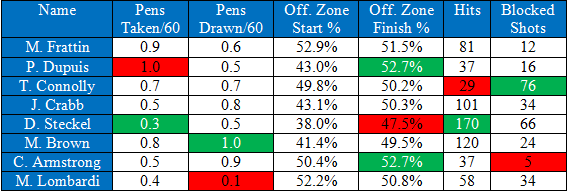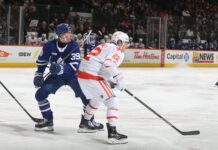
Another year, another disappointing season for the Toronto Maple Leafs. A fantastic start was soured completely by a late season collapse from top to bottom, culminating in another post-season disqualification. So here we arrive again at my end of the year review. This week we’ll be focusing on the bottom 6 forwards on the Leafs, of which there were eight: Matt Frattin, Philippe Dupuis, Tim Connolly, Joey Crabb, Dave Steckel, Mike Brown, Colby Armstrong and Matthew Lombardi. I ended up deciding on who to include based on the number of games played, with 20 being the minimum. This took out a few players, like Jay Rosehill and Colton Orr. With all of that said, let’s take a look.

Pretty unspectacular across the board. Connolly ends up with a decent number of points, but sits well below his career average before this season. In fact, the only person who surpasses their career average ends up being Joey Crabb, whose rather surprising scoring streak upon his initial call up carried him there. Philippe Dupuis’ no points this season is not something Leafs fans are likely to forget, considering the hatred he received in his brief tenure. Armstrong and Lombardi both sit incredibly low in points compared to their career averages. Both have battled injuries and it seems that at least in the case of Armstrong, it could lead to a bus ride to the Marlies. Lombardi is a bit of a different case. Having so recently returned from a major concussion (and not the first of his career), it is at least understandable that some of his speed was lost due to a lack of training in the offseason. Don’t be surprised if Lombardi comes back stronger next year.

Looking at some relatively offensive-minded advanced stats provides us with a few answers. Frattin, Connolly and Lombardi all have on-ice shooting percentages that match up with expected values, with Armstrong well below that point. Crabb, on the other hand, has a pretty high on-ice shooting percentage which is likely not sustainable into next season. As for Dupuis, you are reading that right. At even strength, no Leafs player scored while Dupuis was on the ice. On the opposite end, he sits with a comfortable lead for on-ice save percentage, something I doubt many would have expected. His PDO comes out to a very low 966, but if he had obtained the average on-ice save percentage of the other seven, his PDO would drop to 904.
As for PDO (on-ice sh% + on-ice sv%) itself, it says a lot of this group. Though a general guideline is to use 1000 as a player’s baseline, career averages work better. Take, for instance, Colby Armstrong. His 939 PDO is by far the lowest in the bottom 6. As PDO can be interpreted as a “luck” stat, there are two conclusions we can draw from this PDO rating. One, that Armstrong had a really unlucky year, with a bounce back being probable or two, that the numerous injuries have caught up to him and he’s now broken. It’s not an easy choice, but personally I lean towards the second option. Management will have to make that determination this off-season.
Most of the other players on this list have low PDOs as well. Mike Brown and Matthew Lombardi can also be explained through injuries if one so chooses. Tim Connolly was heavily suspected of playing through injuries most of this season. And Philippe Dupuis is just no good. Though Steckel is below his career average somewhat this season as far as PDO, his other years are also quite low. The biggest factor there is his shooting, where he himself is not a great shooter and he usually plays on the fourth line, meaning his linemates likely cannot shoot well either.
Matt Frattin and Joey Crabb are the only players in this review with a higher than 1000 PDO. Frattin has an unreal shot, so I’m inclined to believe that his shooting percentage will stay steady over his career. As for Crabb, it becomes a bit of a different beast. His on-ice shooting percentage this year is well above his previous two seasons with Toronto (8.98%) and Atlanta (8.33%). However, his PDO this year managed to be lower than last season’s 1009, thanks in no small part to playing in front of the Vezina version of James Reimer. If we suppose that the goaltending will be league average next year for the Leafs and also that Crabb’s on-ice shooting percentage will lower to expected values, it’s easy to come to the conclusion that we many have witnessed the best year that Crabb is going to have in the NHL this season.

Exactly half of the eight players outlined drew more penalties than they took. Philippe Dupuis again stands out in a negative way, having taken twice as many penalties as he drew. This is even more heinous when we consider that the early part of the season was when Toronto’s penalty kill was almost historically awful. Lombardi is another stand out, having drawn only 0.1 penalties per 60 minutes. The loss of his speed was the most important aspect here, as his last full season with Phoenix saw him draw 0.7 penalties per 60 minutes. In fact, you could say that Mike Brown’s leading drawn penalties stat is based primarily on his own speed.
As awareness of advanced stats rises, so too do associated values. Dave Steckel started only 38% of his shifts in the offensive zone, a number that is likely to get even lower in successive years. It’s lower than each of Steckel’s previous three seasons (42.3%, 40.3% and 50.1%). Don’t be surprised if Randy Carlyle has him hovering around 20% next season. It also puts into perspective his finish percentage. He has the lowest offensive zone finish percentage of the players outlined above, but also has the largest positive difference between his starts and finishes (+9.5%). It is a testament to his ability to defend in his own end and move the puck in the other direction.
Though not advanced stats, hits and blocked shots are incredibly important in determining the value of a player. That said, there are a number of players well below expected hits markers who don’t make up for this sufficiently with blocked shots, including Lombardi, Armstrong and Dupuis. Steckel leads the way in hits and ranks second in blocked shots, further accentuating his importance to the bottom 6. Also, despite what Glenn Healy might say, Tim Connolly is in fact an excellent shot blocker. He has been with every team he’s been on and it’s no different in Toronto. He’s an important mainstay on the penalty kill.
In summation, look for bounce back years for Connolly and Lombardi, with likely regression from Joey Crabb. If Connolly does indeed bounce back, the addition of Tyler Bozak to the bottom 6 will do wonders for the third line. Armstrong seems to be a dead man walking in Toronto, with a demotion seeming more and more likely. Frattin may be called upon to play a role in the top 6 next year, as indicated by his first line time in the last few games of the 2011-12 season. Dave Steckel and Mike Brown are likely to stay and anchor the fourth line. However, work must be done to improve scoring in the bottom 6. If Tyler Bozak and Nikolai Kulemin replace Tim Connolly and Matt Frattin next season, there will still be holes in other areas. There is almost as much work required in the bottom 6 as the top 6 for Toronto.






























![Craig Berube Post Game, Leafs 6 vs. Sabres 3: “Our team played really hard in front of [Murray]… They were dialed in for him” Craig Berube, Toronto Maple Leafs head coach](https://mapleleafshotstove.com/wp-content/uploads/2024/12/berube-leafs-tor-pg-100x70.jpg)


